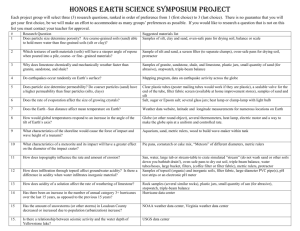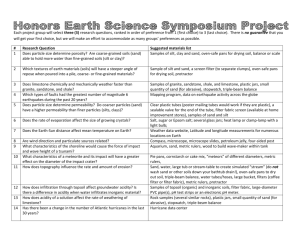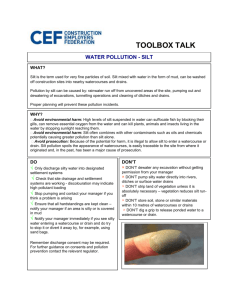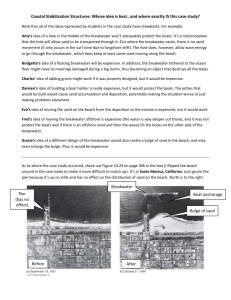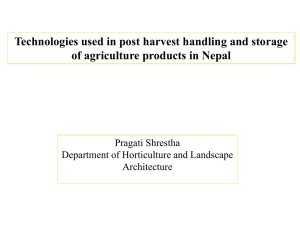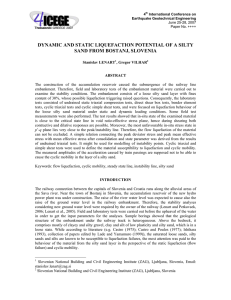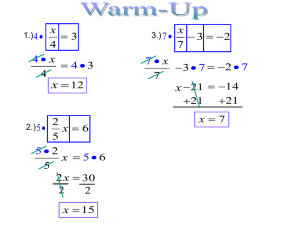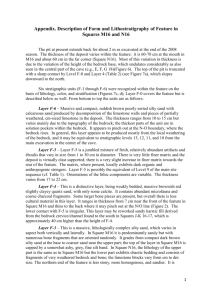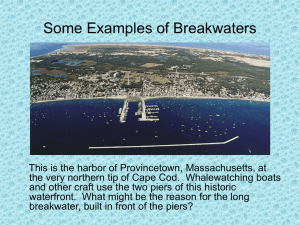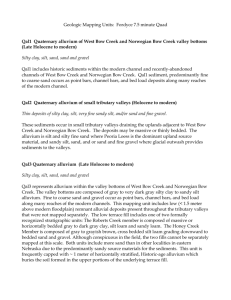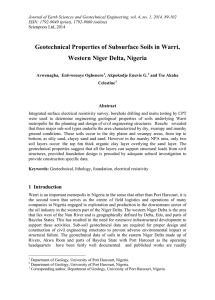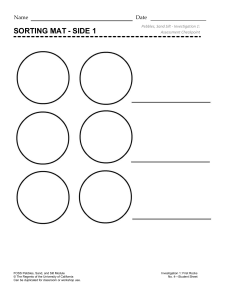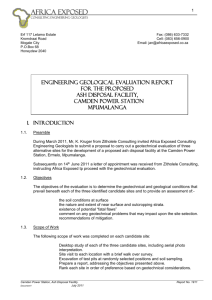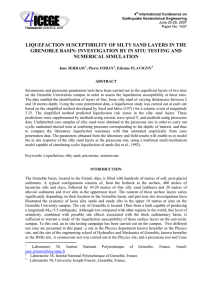Vibroflotation - Geoengineer.org
advertisement
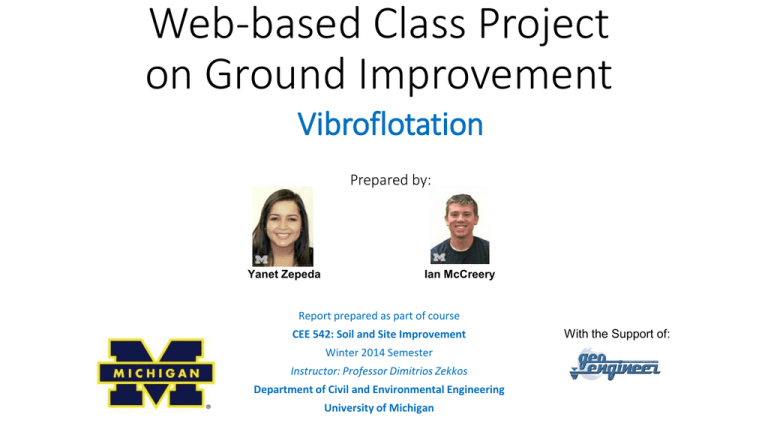
Web-based Class Project on Ground Improvement Vibroflotation Prepared by: Yanet Zepeda Ian McCreery Report prepared as part of course CEE 542: Soil and Site Improvement Winter 2014 Semester Instructor: Professor Dimitrios Zekkos Department of Civil and Environmental Engineering University of Michigan With the Support of: Vibroflotation http://www.cyes.es/images/obras/69/imagenes/max/00105%20AMPLIACION%20DARSENA%20SUR%20PTO%20VLC%201.JPG Ian McCreery & Yanet Zepeda Overview ❏ ❏ ❏ ❏ ❏ ❏ ❏ Introduction Applicability Equipment & Construction Design Cost Case Study: Success Case Study: Failure Introduction Vibroflotation utilizes horizontal vibrations in conjunction with fluid to reduce the interparticle friction of the surrounding soil. http://www.polbud-pomorze.ru/en/vibroflotation/ Introduction During vibration material falls into a denser state. Result: Increase in strength and a reduction in compressibility. Densification of soil during vibroflotation (Bauer Maschinen GmbH, 2012) Introduction Uses: ❏ Reduce potential settlement ❏ Seismic liquefaction mitigation Common for: ❏ Off-shore projects ❏ Land made of reclaimed soil ❏ Hydraulic fills Applicability Most coarse-grained soils with a fines content of less than 10% are considered acceptable. Ideally, loose soils below the water table. Applicability Problem with Cohesive Soils: Fills voids between larger particles and immobilizes the material due to positive pore water pressures; this inhibits the ability of the granules to move into a denser state. http://www.vibromenard.co.uk/techniques/vibro-compaction/ Applicability The orange area represents the grain size distribution of soils suitable for vibroflotation (Bauer Maschinen GmbH, 2012) Equipment ❏ ❏ ❏ ❏ Composed of vibroflot and follow-up pipe Capabilities vary by manufacturer About 12 feet in total length Weigh about 10,000 to 20,000 lbs Equipment ❏ Electric or hydraulically powered motor to rotate a mass ❏ Centrifugal force generated: 43,000 to 70,000 lbs ❏ 2 Jets ❏ Bottom ❏ Upper http://i00.i.aliimg.com/photo/v0/24033 4132/VFA200_Hydraulic_Vibroflot.jpg Construction Procedures ❏ Reach depths up to 150 feet ❏ Densification achieved 5 to 15 radially from vibroflot Construction Procedures ❏ VF trial ❏ Soil penetration ❏ Densification at desired depth ❏ Retract probe to next location ❏ Backfill Construction Procedures ❏ Vibroflot Starving ❏ Quality Control ❏ ❏ ❏ ❏ ❏ ❏ ❏ Penetration Depth Penetration Rate Withdrawal Rate Probe Location Power Peak Operating Frequency Post-Operation Density Checks Design Density goal set in terms of relative density Spacing Patterns: Square, Triangular, Line Cost Highly Variable Croton Dam Case Study (1999) Cost Case Study: Success Seabird Naval Base at Karwar in Indian state of Karnataka. Construction of 3 mile long breakwater structure. Project Seabird (Sharma, 2004) Case Study: Success Existing seabed was composed of clay and soft silt, it was dredged to a depth of nearly 20 feet with hydraulic sand fill. Problem: CPT’s revealed need for compaction of top 13 feet to reduce settlement and mitigate liquefaction Case Study: Success 35 acres selected for compaction Four 49 foot long vibrators suspended from a crane situated on a barge Project Seabird setup (Raju et al., 2003) Case Study: Success Results & Conclusion: CPTs performed every 164 feet along the breakwater structure. The 13 feet of compacted fill achieved a twofold to threefold increase in penetration resistance compared to the uncompacted values. Vibro flotation densified the hydraulic fill beneath the breakwater structure successfully. Case Study: Failure Thermalito Afterbay in Northern California 8 mile long embankment, 39 foot height Case Study: Failure August of 1975 an earthquake of magnitude 5.7 revealed an active fault that had not been previously detected. Department of Water Resources evaluated the embankments resistance to liquefaction under a 6.5 magnitude earthquake. Case Study: Failure Analysis predicted that the silty sand layers in the foundation of the embankment would liquefy entirely under these seismic conditions. Densification of these silty sand layers was necessary to mitigate liquefaction risks. Case Study: Failure Foundation made of layers of different soils including clay, silt, sand and gravel. Surface layer throughout most of the embankment was composed of a clay and silt layer several feet thick. Silty sand layers contain a median of 15 percent fines, with 30 percent of the samples containing more than 20 percent fines Case Study: Failure Vibroflotation testing program implemented Thermalito Bay worksites table (Harder et. al., 1984) Case Study: Failure Vibroflot was not used to penetrate the clay and silt surface layer, here pre-drilling was used until silty sand layer reached then holes were backfilled before vibroflot was inserted. An equilateral triangular spacing scheme was utilized with spacings ranging from 6.5 feet to 9.5 feet. Case Study: Failure Results for Worksite 2. No appreciable improvement. Same for Worksite 1. Thermalito Bay CPT and SPT results (Harder et. al., 1984) Case Study: Failure Conclusion: Vibroflotation is not an effective method for the densification of silty sands below a cohesive soil cap. The failure of vibroflotation as a technique in this case is most likely due to the relatively high fines content of 15 percent in the silty sand layer. Conclusions Vibroflotation is a successful and cost effective technique used to densify loose coarse-grained soils Questions More Information More detailed technical information on this project can be found at: http://www.geoengineer.org/education/web-based-class-projects/select-topics-in-groundimprovement
